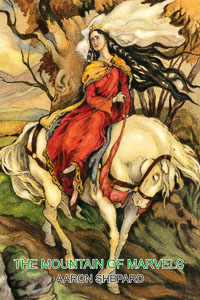Here is the note that appeared in my mini-novel.—Aaron
In the late Middle Ages in Wales, a number of traditional stories were brought together and preserved in a collection we now call The Mabinogion (“mah‑bin-O-gee‑un,” hard g). The core of this collection was The Four Branches of the Mabinogi (“mah‑bin-O‑gee”), a set of interrelated tales compiled by a single anonymous author sometime around the twelfth century. It is in the Four Branches that the tales of Pwyll, Rhiannon, and Manawydan are found.
The Four Branches were actually a literary synthesis of tales told for centuries by professional storytellers in royal courts. Along the way, these stories had gathered elements from a number of historical periods, all telescoped into a legendary past that never existed quite as portrayed.
Dyfed was a Welsh kingdom of the early Middle Ages, and the stories of the Four Branches are nominally set in that period. In the Wales of that time, a king would maintain a number of fortresses, visiting them in a regular circuit, accompanied by his fighting men and other retainers. At each of these “courts,” he would feast and hunt for weeks at a time, supported by the hospitality of the locals.
Military prowess and generosity were among the prime values in this society, and a king had to exemplify both. Another such value was honor, and the humiliation of a noble called for monetary compensation or revenge. A nobleman’s kin were expected to share in his obligations and disputes.
As in most militant societies, women had a subordinate role, but a strong woman like Rhiannon could still make her place. Marriage was a simple affair: The couple had only to make known its intention, then spend a night together.
Though the setting of the Four Branches is supposedly early medieval, the descriptions of daily life, custom, and politics show the influence of later centuries. It was in the twelfth century, for instance, that the remaining Welsh kings took the title of “Lord.” It was also in this period that Celtic brutality began to lose its edge, and a note of gentility emerged. In earlier times, few tales ended without at least one or two heads cut off.
Alongside these later influences are ones more ancient. Most of the characters and many of the plot motifs in the Four Branches derive from Celtic mythology in the centuries before Christ.
Rhiannon, for instance—whose name means “Great Queen”—has been linked to Epona, the horse goddess of the continental Celts, who was often portrayed riding at an amble and carrying a magical bag. In the same way, Pwyll may have earlier been king of a supernatural Otherworld, and Manawydan a sea god. These divinities were “demoted” when the Celtic peoples of Britain and Ireland adopted Christianity—yet they kept their hold on the Welsh imagination.
Though this retelling is in my own words, I’ve done my best to retain the flavor of the original. To better unify the tale, I’ve reassigned some actions among the original characters—much as the compiler of the Four Branches did with his own source material.
Mabinogion translations consulted were those by Charlotte Guest (1849), Gwyn Jones and Thomas Jones (1948), Jeffrey Gantz (1976), Patrick Ford (1977), and Gwyn Thomas and Kevin Crossley-Holland (1985). The last of these, Tales from the Mabinogion (Overlook Press)—comprising the Four Branches only—has an illustrated format aimed at young readers.
